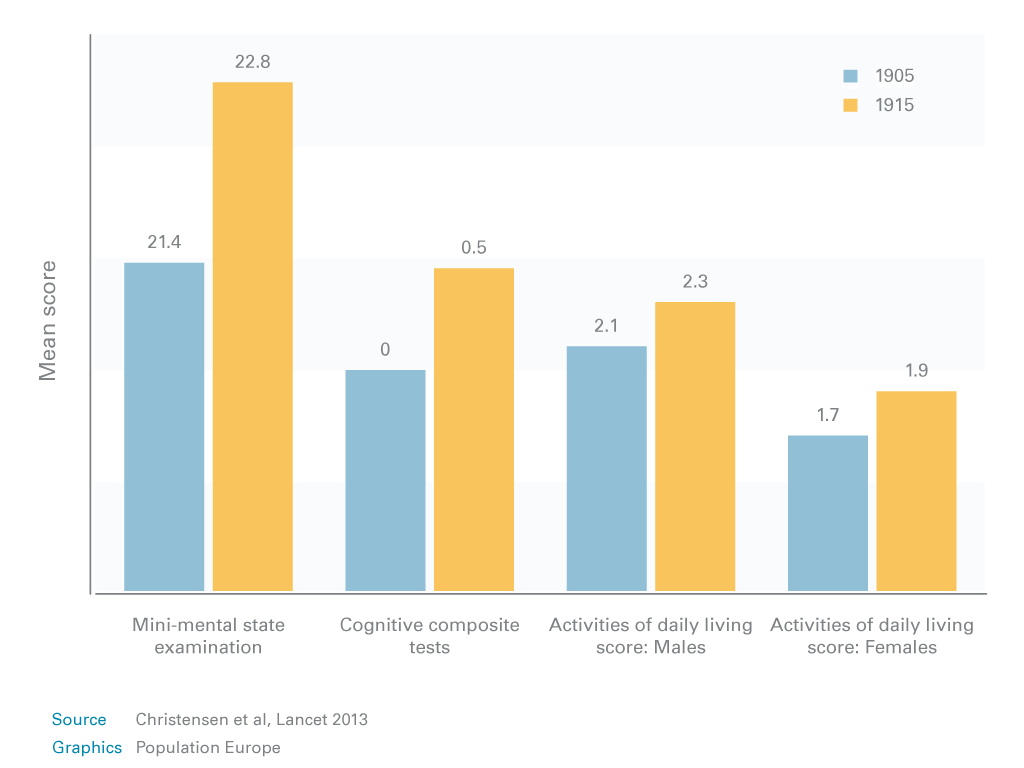A rapidly increasing proportion of people in high-income countries are surviving into their tenth decade. This population will continue to grow in the future, both in absolute terms and as a proportion of older people. This development raised concerns about the extent of frailty and disability in those age groups and the attached personal and societal costs.
However, very little is known about the health status of much older people and for those living in residential care for whom the issue is most relevant. Also very little research has been done using large, national and well-defined birth cohorts. To fill this research gap, Kare Christensen and his co-authors compared the cognitive and physical functioning of two cohorts of Danish nonagenarians, born 10 years apart, in 1905 and 1915. The cohorts were identified through the Danish Civil Register System, which since 1968 has kept a record of all people living in Denmark. No exclusion criteria were applied: all individuals born and living in this country during the relevant study periods were approached, irrespective of type of residence, health, or cognitive status. The 1905 cohort includes a total of 3600 people and the 1915 cohort a total of 2509 people. The assessment consisted of an interview, physical and cognitive tests, and the collection of biological samples like blood sample or a cheek swab.
Biggest improvements in cognitive functioning
Results show that the chances of surviving from birth to age 93 was 28% higher in the 1915 cohort than in the 1905 cohort (6.50% versus 5.06%), and the chance of reaching 95 years was 32% higher in 1915 cohort (3.93% versus 2.98%). Despite being two years older when assessed, the 1915 cohort scored significantly better than the 1905 cohort on both the cognitive tests and those related to activities of daily living. This suggests that more people are living to older ages with better overall functioning. Cognitive functioning showed the clearest improvement between the two cohorts, whilst tests on physical performance and depression symptomatology revealed no differences. For both the mini-mental state examination and the cognitive composite tests, men had better scores then women in both cohorts.

Graph 1: Test-results for the two different cohorts: Mini-mental state examination measured on a scale from 0 to 30, cognitive composite score measured as a composite of five cognitive tests sensitive to age-related changes (mean 0, Standard Deviation 3.6) and activities of daily living assessed with a scale form 1 to 4.
These findings suggest that improved activities of daily living at very old age are mainly based on improved cognitive functioning and better living conditions, including better aids to support mobility and independence like walking aids, sophisticated grab bars, threshold ramps or swivel seats.
Beneficiaries of Medical Progress
Two opposing processes affect the health of successive cohorts: On the one hand, a later cohort might benefit from advancements in health resulting from more effective disease prevention like influenza vaccination, drugs to control high blood pressure and cholesterol, or improved treatments of heart disease and cancer. Along with such direct medical gains, peoples’ health also benefits from better standards of living, increased educational achievement, healthier diets and exercise. Such progress helps the members of the later cohort to reach older ages in better health. This process is known as the success-of-success effect: improvements in health at earlier ages result in a healthy cohort at older ages.
On the other hand, the later born group is larger than the earlier one because of the lives that have been saved: the additional survivors might be in relatively poorer health and might have died if they had lived in earlier cohorts with less favorable living conditions and poorer medical treatments. This process is known as the failure-of-success effect: saving lives might reduce average health by enabling very frail individuals to reach older ages than they would have otherwise done.
Results from this study show a positive development between birth cohorts, with no evidence of a net failure-of-success effect. On the contrary, the 1915 cohort performed better on the cognitive tests and the activities of daily living scale than did the 1905 cohort despite being two years older, which suggests a net success-of-success effect, with more individuals living to older ages with better overall functioning.
This PopDigest is also available in French, Spanish and German.
This Population Digest has been published with financial support from the Progress Programme of the European Union in the framework of the project “Supporting a Partnership for Enhancing Europe’s Capacity to Tackle Demographic and Societal Change”.